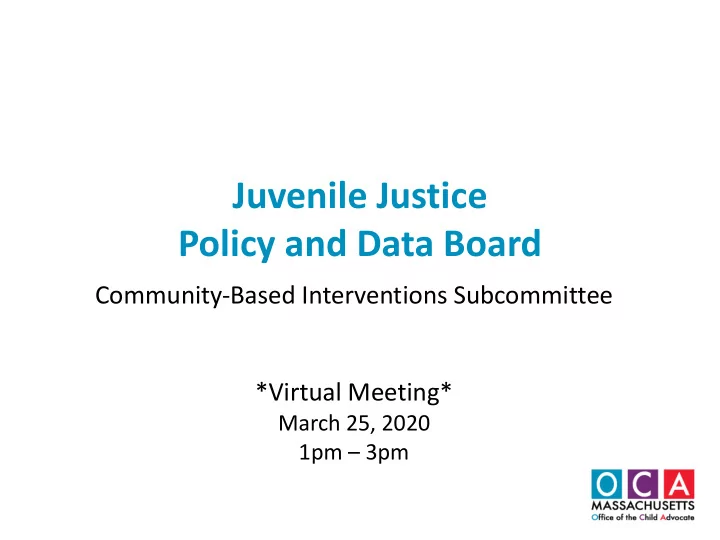

Juvenile Justice Policy and Data Board Community-Based Interventions Subcommittee *Virtual Meeting* March 25, 2020 1pm – 3pm
Agenda • Welcome and Introductions – Virtual Meeting Guidelines • Review/Approval of February meeting minutes • Presentation/Discussion re: Developing Diversion Agreements and Case Plans
Today’s Overview 1) Goals • What do we hope to achieve with the diversion agreement? 2) Understanding Context •What do we need to know/understand to determine appropriate intervention(s)? •How should risk/need assessment tools be used as part of diversion process? 3) Interventions • What are examples of appropriate interventions? • How have other jurisdictions used context to set interventions? 4) The Agreement • What becomes a condition of diversion? • What do we focus on & hold youth to?
1) Goals of Diversion Agreement 1) Don’t over- Reduce the intervene likelihood of 2) Target future criminogenic offending risks/needs Support Diversion Promote positive Agreement accountability youth for actions Goals development Equity
1) Goals of Diversion Agreement Are these the correct goals to Reduce the use when developing likelihood of future diversion agreement? offending Support Diversion Promote positive Agreement accountability youth for actions Goals development Equity
2) Understanding the Context: Sources of Information Youth Needs •Risk/Needs Assessment Youth Risks Youth Voice •Risk/Needs •Interview Assessment Prior History Family Voice •CORI •Interview •Interview Victim Input Incoming Offense • Interview • Police/other report • Other official • Interview documents
2) Understanding the Context: Sources of Information Youth Needs • Risk/Needs Assessment Youth Risk Youth Voice • Risk/Needs • Interview Assessment Are all of these needed to inform diversion case planning? Prior History Family Voice • CORI Is anything missing? • Interview • Interview Victim Input Incoming Offense •Interview •Police/other •Other official report documents •Interview
2) Understanding the Context: Use of Risk/Need Assessments Pros: Cons: Can reduce implicit bias Misclassification of youth of color Can help determine interventions Interpretation of results can vary likely to be most effective (need effective training/QA) Can improve resource allocation Stigmatization of the youth (focus resources on highest risk/need) Improve practice consistency Time/resource intensive to conduct
2) Understanding the Context: Use of Risk/Need Assessments Short Full No Screen(s) Assessments Assessment Triage for All (e.g. South Dakota) (e.g. Suffolk County DA; (e.g Delaware) Fairfax County)
2) Understanding the Context: Use of Risk/Need Assessments Should we be using an assessment tool to inform understanding of youth risks/needs? If yes, should all youth receive a full assessment, or is a triage approach more appealing? What criteria would we recommend to inform tool selection process?
3) Interventions: Kentucky Kentucky Diversion Case Plan Parent/Guardian concerns/goals for youth & family Youth concerns/goals for youth & family Focus Area (Criminogenic Needs), Goal, Potential Barriers, Action Steps, Individual Responsible, Target Date
3) Interventions: Louisiana
3) Interventions: Fairfax County VA
3) Interventions: Cambridge Safety Net YLS/CMI Service Referral Matrix N��� A��a� Fa���� C�������a����� E���a����E��������� P��� R��a���� S����a��� U�� L�������R����a��� P�����a�����B��a���� A�������O�����a��� Pa������ Rec�g�i�e Famil� Pa�e���g Rec�g�i�e Ed�ca���� Rec�g�i�e Pee� Rela���� a� C���ide� �he�he� S�b��a�ce Rec�g�i�e Lei���e�Rec�ea��� Rec�g�i�e Pe����ali��� Rec�g�i�e A���de�� a� ���e��al ���e�g�h a�d Em�l��me�� a� a ���e��al ���e��al ���e�g�h a�d Ab��e ��e�e���� a� ���e��al ���e�g�h a�d Beha�i�� a� ���e��al O�ie��a��� a� ���e��al c���ide� addi�g �����g ���e�g�h a�d c���ide� addi�g c���ide� addi�g �ee� g���� ���g�ammi�g ma� be hel�f�l c���ide� addi�g ������� ���e�g�h a�d �ee if �he�e ���e�g�h a�d �ee if �he�e �a�e��al i���l�eme��� �ch��l �e����ce� �� j�b i� i���l�eme�� i� ��ea�me�� ac��i�e� �� c�ache��me����� ���i��e �e����ali�� fac���� ���i��e a���de� a�d de�i�e L�� ��e��igh� i� ��ea�me�� ��ea�me�� �la��i�g �la��i�g i� ��ea�me�� �la��i�g ca� e�ha�ce ��ea�me�� �� d� �ell ca� e�ha�ce �la��i�g �la��i�g �e�g�� �e�ilie�c�� ��ea�me�� �la��i�g �e�g�� g�al leade��hi�� e�c�� - ��ie��ed� �e��ec� f�� a��h��i��� e�c�� � CBHI - I� - h�me �he�a�� � SPED e�al�a�����e - � Afue��ch��l ���g�am � Pa�e�� - child c����ac� �� � Me����i�g ���g�am � O���a�e�� The�a�� � O���a�e�� The�a�� �IHT� ���� I��e��i�e Ca�e e�al�a��� ��b��a�ce ��e � Em�l��me�� ���g�am � Afue��ch��l ���g�am � The�a�e��c g���� � The�a�e��c g���� C���di�a��� �ICC� � T����i�g � O���a�e�� d��g ��ea�me�� � Me����i�g ���g�am � A�hle�c P��g�am � Medica��� e�al�a��� �� � Medica��� e�al�a��� �� � Famil� S������ � ���g�am � Sch��l - ba�ed beha�i��al �� ma�ageme�� �� ma�ageme�� E�gageme�� P��g�am �������� � Me����i�g ���g�am � Me����i�g ���g�am M����a�� S���� � Me����i�g ���g�am � Em�l��me�� P��g�am � Afue��ch��l ���g�am � Afue��ch��l ���g�am � O���a�e�� �he�a�� � A�hle�c P��g�am � A�hle�c P��g�am � Famil� ������� � � Di�c��� �e��e���g SPED � The�a�e��c g���� � I��e��i�e ����a�e�� d��g � The�a�e��c me���� � Eme�ge�c� me��al heal�h � Eme�ge�c� me��al heal�h e�gageme�� ���g�am e�al�a�����e - e�al�a��� ��ea�me�� ���g�am �c�ee�i�g �c�ee�i�g �i�h �a�e���g�a�dia� � DCF i���l�eme�� �ia ��A� � De��� � ��abili�a��� � O���a�e�� ���ch�l�gical � O���a�e�� ���ch�l�gical � Em�l��me�� P��g�am CRA �efe��al� �� ��l���a�� ���g�am e�al�a��� e�al�a��� �e��ice� a��lica��� � Al�e��a��e di�l�ma � Re�ide��al d��g ��ea�me�� � Pa��al H���i�ali�a��� � J��e�ile C���� I���l�eme�� H��� � I��e��i�e IHT �ia DCF ���g�am P��g�am �ia CRA a��lica��� � Rec��e�� High Sch��l � The�a�e��c me���� � J��e�ile C���� I���l�eme�� � Life �kill� ���g�am � Y���g �e��le ’ � AA mee��g �ia CRA a��lica��� � DMH �efe��al � DMH �efe��al
3) Interventions: Milwaukee
3) Interventions What do you like about any of the models presented? What concerns do you have about any of the models presented?
4) The Diversion Agreement: Conditions Reminder re: Goals of Diversion Agreement Reduce the 1) Don’t over- likelihood of future intervene offending 2) Target criminogenic risks/needs Support Diversion Promote positive Agreement accountability youth for actions Goals development Equity
4) The Diversion Agreement: Conditions Examples of Conditions in Other Jurisdictions (CT, NH, NC, OH): Participation in Community-Based Program Follow all school rules/regulations and policies and attend school daily Community Service Not to consume any alcohol or illicit drug use Restorative Justice Program/Process Drug/alcohol testing Restitution Curfew Payment of Diversion Fee Attend all scheduled appointments with Diversion Coordinator Participation in Counseling/Therapy Check in calls with Diversion Coordinator Follow rules of parents/guardians No involvement in any further offenses
Recommend
More recommend